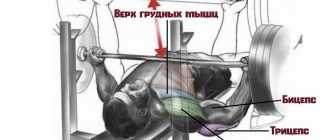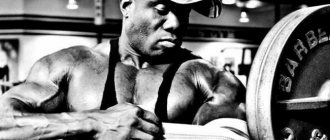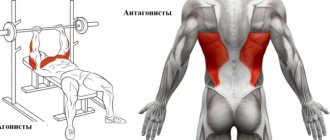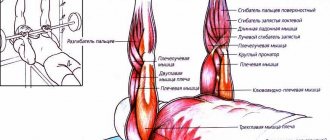This is one of those problems that is easy to fix. When you're dealing with dead spots in your bench press, you need to remember that there are several ways to fix the problem, but most won't work for you. So don't ride a dead horse!
In other words, if what you're doing isn't working, try something else. You have a lot of ammo.
I too have had problems with the bench press and sometimes it takes years to find the right exercise to solve it. Or you can find the right path right away.
Start lowering the barbell from the place where you will raise it
This is a very simple habit, but not everyone has it. Most lifters remove the bar from the rack and immediately begin to lower it without securing it. This becomes a habit and forces you to lower the bar diagonally, which will lead to the rise in the same manner. When you lift the bar toward the racks, it overloads your shoulders and takes the emphasis off your triceps.
After removing the bar from the racks, you must move it to the point where you will lift. It should be slightly higher than the place where you will lower the barbell. If you are lowering to the lower chest area, the bar should be secured above the lower chest before lowering. This will ensure a straight trajectory in both the eccentric and concentric phases.
Remember, the shortest distance between two points is a straight line.
Dojims
The push-up technique is used to increase the strength performance of athletes in strength sports and as a way to combat adaptation to training, which is accompanied by a lack of progress. It is performed using the classic bench press technique, but the bar does not fall to the chest. There are different options for boosters, for example, the bar can be lowered by 10-20 cm or even lower. The weight is selected depending on the main goal of the workout. To increase the strength of the athlete, the exercise is performed with a large weight, but a small amplitude of push-ups for 2-4 repetitions.
Strengthen the top
There are several exercises that can help you strengthen the muscles that perform the push. They are best done using the MU method. The best exercise to combat weak pressing is the 3 or 4 board press. Lower the bar onto the boards, pause and press up. In extreme cases, you can use mini bands.
The second exercise that works very well is the chain floor press. The floor press is done in the same way as a regular bench press, except you lie on the floor. Work with about 60-70% of your best bench press, then start adding one chain to the bar on each side for each set. When you can't add any chains, call it a day.
Find solutions to other bench press problems here.
Doing the bench press correctly!
The bench press is a basic free weight exercise. The person performing the exercise lies down on a bench, lowers the bar until it touches the chest and raises it until it is fully straightened at the elbow joint. Used in bodybuilding as an exercise to develop the pectoral muscles, triceps and anterior deltoid muscle. It is one of the main disciplines in powerlifting (along with squats and deadlifts).
Classic press
The classic press is done lying on your back on a bench press bench. In the starting position, the barbell is held with outstretched arms above the chest. Then the barbell is lowered to the chest and pressed up again onto outstretched arms. There is an alternative option: the bar in its initial position rests on the frame stops at chest height and is then squeezed out of this position to outstretched arms and lowered again onto the stops. Breathe evenly and clearly every time you rise. Inhalation is done while bending your arms with a barbell. The lungs are filled with air when the bar touches the chest. Lifting the weight is accompanied by a powerful exhalation. Control your grip and elbow position. The exercise should be comfortable to perform, but some may find it uncomfortable to switch to the correct grip of the bar: the thumb and index fingers close together, covering the bar. The hand and elbow are always in the same line, perpendicular to the floor. Perform 2-4 sets of 5-10 presses to gain muscle mass. Increase the weight and do less bench presses. If you're shedding pounds at the gym, use lighter weights while doing more barbell presses.
Bench press
For the “lifter” press, the basic elements of the classic bench press technique remain unchanged, but it uses a back arch. After all, this is logical, since the main task in powerlifting is to lift more weight. And due to the deflection, the trajectory is shortened and additional muscle groups are activated. When performing a bench press in this style, it is recommended to do it with a pause at the bottom point, as provided for in the rules of competition in powerlifting and bench press. If, of course, you plan to participate in them.
The world record for the backbend bench press belongs to Ryan Keneally. He was able to bench press 486 kg. Although Keneally did not perform this exercise very cleanly, he was not able to fully straighten his arms, the judge recorded a record.
Negative repetitions
Negative repetitions, everyone loves them. Choose a weight heavier than what you usually bench press with and ask a friend to help you. Start in a fully extended barbell position and slowly lower it to your chest, resisting the weight all the way down. The path of the projectile from top to bottom must be at least 5 seconds. Using the support of a friend, press the projectile up onto your straightened arms and repeat the movement.
How to increase weight on bench press
Single reps
We hang almost maximum weight on the barbell (about 95% of the maximum). Your task is to complete 3-4 sets of just one repetition. Please note that recovery from singles lasts 4-7 days (sometimes more), depending on the training and general physical condition of the athlete. Don't get too carried away with single repetitions, otherwise you can easily end up in a state of overtraining.
Legs
To increase the initial momentum of the chest push, you will have to train your legs, and very hard. It may sound counterintuitive, but the lower body serves as the foundation for benching power. At the beginning of a properly performed bench press, your body is like a compressed spring, with all its potential energy concentrated in your legs. If you fail to train your lower body sufficiently to “unspring” as hard as you can, you will sacrifice a significant portion of the weight you would otherwise be able to push. To be able to build this kind of foundation, you will have to dedicate one training day entirely to developing your lower body. You will squat, deadlift, and prepare your leg muscles to initiate and support the bench press.
Pyramid
You can’t immediately try to raise your maximum. An obvious one, but one that many lifters make, let's say you want to lift your maximum of 100 kilograms per rep. It’s stupid to start with 100 kilograms right away. Instead, you should first warm up with warm-up weights, and then pyramid the weights up, gradually getting closer to your maximum, for example, you could first do 50 X 6 (obviously not "to failure", but only for warming up), then lift weight up to 70 X 5 (also not “to failure”), then 80 X 2 (not “to failure”, but already quite heavy), then 90 X 1, and only then try your 100 kilograms.
Grip and muscles
Maximize the recruitment of your strongest muscle groups and minimize the recruitment of your weaker ones by adjusting your grip width and hand position. The proverbial sticking point usually occurs due to the weakness of one muscle group compared to another. When the movement approaches the point where weak muscle areas are maximally involved in the work, the bar stops. For example, most often the dead point in the bench press is located in the middle of the movement path, where the front deltoids are already working less, and the chest and triceps are working more. If they are weaker than the deltoids, you will stop. One way to solve the problem is to adjust your grip width to minimize the work of weaker muscle groups and maximize the stronger ones.
Bench press technique. Video
Source
Shall we turn on some music to set the mood?
Now playing:
Open Kluber FM website | iOS app | Android app
Features and Benefits
The barbell press lying on a bench (straight or inclined) is one of the basic strength exercises that develops the muscles of the whole body most effectively and comprehensively. To be convinced of this, you just need to familiarize yourself with which muscles work when pressing:
- the main ones acting are the pectoral, or pectoral, triceps and deltoids;
- secondary - the upper abdominal muscles, back muscles, legs and buttocks.
To increase muscle mass in the upper body and create a powerful, pumped, wide chest, the horizontal bench press is a key exercise. It is anatomically comparable to push-ups, but has an important advantage: thanks to the ability to increase weight, it loads the muscles and pumps them stronger.
Like many of the compound movements, the bench press raises an athlete's testosterone levels. This hormone plays an important role in increasing training results.
There are various options for performing the exercise:
- Classic barbell bench press on a horizontal bench - you need to lie on the bench, for balance, place your feet firmly on the floor and, taking the barbell with a medium or wide grip, straighten and bend your arms so that the bar of the apparatus touches your chest. The bench press is also carried out with a narrow grip, so the load falls on the triceps and the inner part of the chest. It is more difficult to perform, since it requires not only the correct technique, but also strength.
- Powerlifting - performed with a strong arch of the back, but it is obligatory to touch the bench with its upper part and buttocks. This option allows you to bench press more, but without special training it is fraught with sprains and other serious injuries, and besides, it is almost useless for building the body and gaining mass.
- With limited amplitude when the bar does not reach the chest. This method is good because during its implementation the structure of the muscles and nerve impulses changes.
- In a power rack, this is a safe option that allows you to bench press a barbell without being supported by a partner.
- The Smith machine offers another way to safely train on your own.
- On an incline bench - lifting the barbell in this way is useful for working the pectoral muscles in the collarbone area, which are little involved in a regular bench press.
Training with dumbbells is ideal for increasing the range of motion and engaging even more stabilizer muscles. However, it cannot be performed with large weights, such as a barbell or scales.
The use of this exercise should be limited in the following cases:
- for injuries of the spine, shoulder, elbow and wrist joints, thoracic region;
- if the athlete cannot do 7-10 pull-ups or 30 push-ups (his athletic form is insufficient to work with heavy weights).
In reasonable amounts, training the pectoral muscles using the bench press is also useful for girls. This makes the body more athletic and harmonious.
Muscles used during the exercise
Classic press
On an incline bench
Powerlifting
In Smith's car
With amplitude limitation
In a power frame
Inclusion in training
The basic principles of training the bench press, as well as many other strength exercises:
- Supercompensation, or the moment when the muscle was not only able to recover, but also slightly improved its trained qualities. At this time, the necessary muscle quality must be trained again.
- Be systematic - a training diary will help you follow it.
- Microperiodization - different muscle qualities, like different types of muscle fibers, require a certain amount of recovery time, so they need training at different frequencies.
For example, glycolytic fibers require 3-5 reps for training with 5-10 minutes of rest between sets. Moreover, the speed of performing the exercise is fast, the total time of the approach, that is, being under load, is 15–20 seconds. In each approach, a positive failure is achieved (when there is no strength to complete the movement on your own). This training is carried out once every 10–15 days. During breaks, be sure to conduct a toning session on high-threshold fast muscle fibers (FMTs).
To work out the BMW, you only need 1-2 repetitions, and the time under load is 3-5 seconds. Rest between sets is also 5–10 minutes. The duration of the workout is determined by reaching the maximum. This way you can train once a week.
Working out endurance oxidative muscle fibers: time under load is 30–40 seconds, rest between sets is 20–30 seconds. After completing 3 approaches, you need to rest longer (5–10 minutes), and then perform three more similar series (each with three approaches). The pace of the exercises is slow with a short amplitude.
Experts advise, in addition to the classic bench press, to include presses and non-presses, negative repetitions, chains, statics in the training program, experiment with the position during the exercise, and avoid one-repetition maximums. Taken together, these methods will not only increase bench weight, but also maintain healthy joints.
Based on the above, one workout per week may not be enough. It is often more beneficial to reduce your training volume, but bench press the barbell twice a week, making one heavy and one medium-load or high-rep. It is highly advisable to find an experienced, successful powerlifter who can help with advice, or even better, a coach who will create a training schedule. Following it while observing the technique will ensure progress.
Bench press crash
If you train with heavy weights without the help of a partner, then you definitely need to follow safety precautions to avoid traumatic situations. You can terminate the exercise abnormally as follows:
- before performing the bench press, remove the locks that secure the plates to the bar;
- if you do not have enough strength to return the apparatus to the rack, carefully lower the barbell to your chest;
- move your right hand on the bar closer to the pancakes and lift it up - the pancakes on the left side should slide to the floor;
- Do the same operation with your left hand, tightly gripping the barbell.
To avoid such situations in the absence of an assistant, it is recommended to perform the bench press in a power rack.
Correct breathing
Performing strength exercises with proper breathing allows you to develop greater effort. The main condition: exhale during the effort, when the maximum load is overcome. Inhale - during the phase with minimal effort. When performing a bench press, it looks like this:
- When lowering the bar, inhale.
- Near the “dead point”, or approximately in the middle of the downward movement, hold your breath and lower the barbell to the bottom point of the trajectory. You cannot exhale “down”, as this will upset the balance of the body.
- When moving upward, about the same “dead point”, a sharp, strong exhalation is made. This helps push the projectile out.
As you exhale, the abdominal press, tensing, stabilizes the entire body, and the chest muscle groups form a strong corset. In this state, developing force, performing the bench press is much easier. Conversely, when you inhale, the chest stretches, swells, and the abdominal muscles relax. In this position, powerful tension of large muscle groups is impossible.
When lowering the bar, inhale
When moving the barbell up at the “dead point” - sharp exhalation











